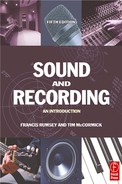Contents
Characteristics of a sound wave
Frequency spectra of repetitive sounds
Frequency spectra of non-repetitive sounds
Displaying the characteristics of a sound wave
Sound power and sound pressure
Practical implications of equal-loudness contours
The moving-coil or dynamic microphone
The capacitor or condenser microphone
Directional responses and polar diagrams
Mounting and loading drive units
An overview of typical mixer facilities
Introduction to mixing approaches
A short history of analogue recording
The magnetic recording process
Mechanical transport functions
Why is noise reduction required?
Line-up of noise reduction systems
Chapter 8 Digital audio principles
Digital and analogue recording contrasted
The digital audio signal chain
Analogue to digital conversion
Changing the resolution of an audio signal (requantisation)
Introduction to digital signal processing
Chapter 9 Digital recording and editing systems
Audio processing for computer workstations
Disk-based editing system principles
Chapter 10 Digital audio applications
Advanced audio processing software and development tools
Preparing for and understanding release media
Interconnecting digital audio devices
Professional amplifier facilities
Chapter 12 Lines and interconnection
Cable effects with unbalanced lines
Connection of outboard devices
Chapter 14 MIDI and synthetic audio control
MIDI and digital audio contrasted
Interfacing a computer to a MIDI system
MIDI control of sound generators
Scalable polyphonic MIDI (SPMIDI)
SAOL and SASL in MPEG 4 Structured Audio
Chapter 15 Timecode and synchronisation
Principles of loudspeaker stereo
Principles of binaural or headphone stereo
Loudspeaker stereo over headphones and vice versa
Two-channel microphone techniques
Binaural recording and ‘dummy head’ techniques
Spot microphones and two-channel panning laws
Four-channel surround (3-1 stereo)
5.1 channel surround (3-2 stereo)
Other multichannel configurations
Matrixed surround sound systems
Digital surround sound formats
Surround sound recording techniques
Multichannel panning techniques
Appendix 1 Understanding basic equipment specifications
Frequency response – technical
Frequency response – practical examples
Harmonic distortion – technical
Harmonic distortion – practical examples
Dynamic range and signal-to-noise ratio
